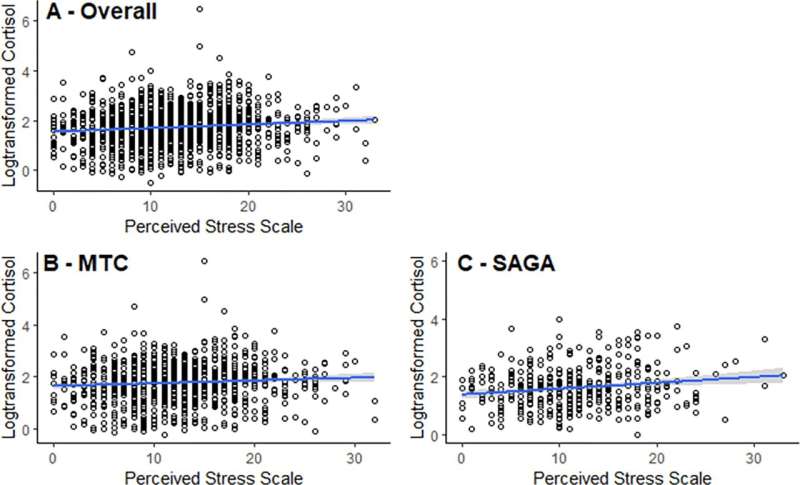Multivariable adjusted linear regression for log-transformed cortisol with 95% confidence intervals, with data from the Mexican Teacher’s Cohort (MTC) (N = 881) and the Icelandic SAGA Cohort (N = 398), both as a combined sample and by cohort according to 10-item Perceived Stress Scale score. The figures are scatterplots with an overlying linear regression and 95% confidence intervals. The results are adjusted for marital status, occupation, educational level, BMI, smoking status as well as cohort for the combined sample. The overall sample (Panel A) had a 1.4% (95% CI 0.6, 2.11) increase in log-cortisol per unit increase of PSS. The Mexican sample (Panel B) had a 1.3% (95% CI –0.7, 3.3) increase in log-cortisol. The Icelandic sample (Panel C) had a 2.0% (95% CI 0.7, 3.2) increase in log-cortisol. Credit: PLOS Global Public Health (2022). DOI: 10.1371/journal.pgph.0000571
A team of researchers from the University of Iceland and the National Institute of Public Health in Mexico City, working with a colleague from TU Dresden, has found evidence that suggests doctors may soon be able to measure recent stress levels in patients by measuring cortisol levels in their hair. The group has written a paper describing their research and have posted it on the open access site PLOS Global Public Health.
Cortisol, also known as hydrocortisone, is a type of steroid made by the adrenal gland. It serves a wide variety of purposes and is produced in abundance when people experience stress. Because of that, it has sometimes been referred to as the stress hormone.
In this new effort, the researchers wanted to know if cortisol winds up in the hair as it grows, and if so, is the amount related to stress levels. To find their answers, the researchers studied data in the Mexican Teachers and Icelandic Stress and Gene Analysis cohorts which included data on hair samples collected from 881 women living in parts of Mexico and 398 in Iceland. Each of the samples was yanked, not cut, so as to be able to test the root section as well. Each hair was also cut to just 3cm. The researchers also noted that hair grows an average of 1cm per month, which meant each hair sample they studied represented the prior three months growth. Each of the women who volunteered to participate in the study also answered a short survey that asked them questions about how stressed they had been feeling over the past three months.
After testing the hair samples and analyzing the surveys, the researchers divided the results into five groups representing the stress levels of the participants, with number scores given to allow for comparison between the groups. In so doing, the researchers found a correlation between the amount of stress reported by the women volunteers and the amount of cortisol they found in their hair—the more stress they had been feeling the more cortisol they found in their hair.
The researchers suggest their findings indicate that cortisol levels in a person's hair can serve as a biomarker representing stress levels in the recent past. They acknowledge that such a test would have to take into account other factors, however, that could have led to increases in cortisol production, such as the use of certain medications or the presence of benign tumors.
More information: Rebekka Lynch et al, Perceived stress and hair cortisol concentration in a study of Mexican and Icelandic women, PLOS Global Public Health (2022). DOI: 10.1371/journal.pgph.0000571
Journal information: PLOS Global Public Health
© 2022 Science X Network
























